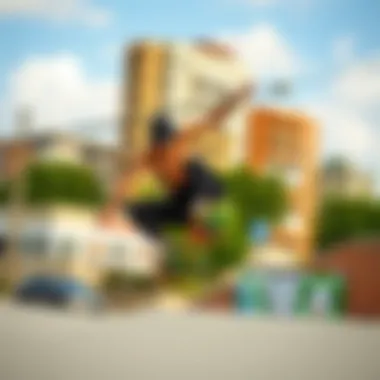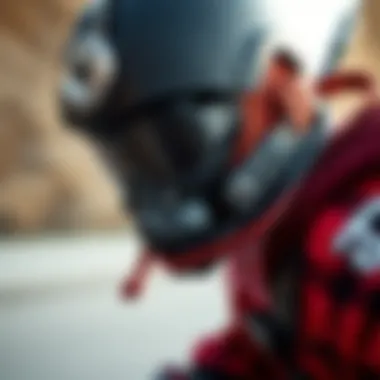Exploring Warrior Skate Culture: A Comprehensive Guide


Intro
In the world of skateboarding, the term "warrior skate" resonates not just with a style or technique, but also as a mentality embraced by many within the skating community. This cultural phenomenon draws parallels between the resilience seen in martial arts and the tenacity shown on the board. As we take a closer look, it becomes clear that warrior skate is a rich tapestry woven from various elements: mindset, skills, gear, and an intricate web of cultural influences.
Skateboarding is inherently a journey of self-discovery and personal growth. It's about more than just tricks; it's about pushing boundaries, confronting fears, and building a sense of community that fosters support and camaraderie among peers. In this guide, we will peel back the layers of warrior skate culture, examining its roots, its evolving nature, and how it manifests through the lens of individual skaters and local scenes.
Throughout this exploration, we aim to equip skateboarders—whether novices or seasoned riders, instructors sharing knowledge, and shop owners looking to understand their clientele’s culture—with insights that truly capture the essence of this unique subculture. Strap on your helmets, as we embark on a journey unveiling the soul of warrior skate!
Prelims to Warrior Skate Culture
Warrior skate culture captures a unique fusion of resilience, tenacity, and artistic expression found within the skateboarding community. This culture is not merely about shredding vert ramps or mastering street tricks; it delves deeper into the mindset and lifestyle that frame the very essence of being a skater. Understanding warrior skate culture means recognizing the struggles, victories, and communal bonds that form through shared experiences on the board.
Defining Warrior Skate
At its core, warrior skate embodies an attitude— a way of confronting life's challenges head-on, much like the historical warriors who fought not just battles but also personal demons. This culture aligns skating with the principles of strength, discipline, and a relentless pursuit of mastery. It’s not just about physical prowess; it also encompasses a mental fortitude that allows skaters to push beyond limits.
Being part of the warrior skate culture means embracing the highs and lows of the journey. Skaters encounter bruised knees and broken boards, but each setback is viewed not as failure, but as a necessary lesson for growth. This mindset positions skateboarders as warriors in their own right, where the battle is fought on asphalt rather than in arenas of combat.
From the catchphrase "skate or die" to the phrase “keep pushing,” these slogans reflect a lifestyle that champions perseverance and determination. The courage to try, fail, and try again— that's the heart of warrior skate.
Historical Context of Warrior Ideals in Sports
To fully grasp the significance of warrior skate culture, it's important to consider the historical context of warrior ideals in sports. Historically, athletes have been viewed as gladiators, engaged in physical contests that test their skill and spirit. From ancient times to modern-day, sports have been a means for communities to express their values, identity, and resilience.
In many ways, skateboarders can draw parallels with those ancient warriors. They face not only the dangers of their sport—whether it’s injury or societal judgment—but they also confront their internal battles like fear, motivation, and self-doubt. Skating evolved as a rebellious act against mainstream sports, and this rebellion itself echoes the warrior spirit: defying convention, pushing limits, and striving for excellence against all odds.
"The essence of warfare is not just in the external struggle, but also in grappling with one’s inner fears and limitations."
As skate culture has gained momentum through the decades—from the vibrant sidewalk sessions of the 1970s to the competitive environment of today—warrior ideals have remained a driving force. The evolution of skateboarding has been heavily influenced by its roots in rebellious, countercultural movements. Every kickflip and grind represents a continuation of the fight for individuality and expression, a nod to those who came before.
In summary, understanding warrior skate culture requires an appreciation for its defining elements: a commitment to resilience, a deep-rooted sense of history, and a collective bond formed through shared experiences. For skaters, it's more than just a hobby; it's a lifestyle that inspires both personal growth and community connection.
Relevant resources to explore include Wikipedia, Britannica, and engaging online communities such as Reddit or local skate shops that foster this vibrant culture.
The Mindset of a Warrior Skater
Understanding the mindset of a warrior skater is crucial to grasping the essence of warrior skate culture. It’s not just about mastering tricks or wearing the right gear. This mindset underscores resilience in the face of adversity, an intrinsic motivation to push personal boundaries, and an unwavering focus on one’s goals. Warrior skaters see the board as a tool for self-expression rather than merely a sport.
The values found in warrior cultures parallel the principles embraced by skaters. This mindset not only defines an individual’s approach to skating but also fosters a deeper connection within the skate community. When you fully comprehend the mental framework of a warrior skater, you're not only better equipped to advance your skills but also to appreciate the wider narrative of skate culture as a whole.
Resilience and Perseverance
Resilience is a cornerstone of the warrior mindset. It is the ability to bounce back from falls—both literal and metaphorical. Warrior skaters often face repeated failures while practicing new tricks or strategies. They understand that failing is just part of the learning curve. They embrace each tumble as a lesson rather than viewing it as a setback. This persistence lays the groundwork for growth.
Skateboarding can be brutal on the body and ego. A skater might break boards, sprain ankles, or land with an awkward thud more often than they’d like. Yet, instead of shying away after a nasty fall, resilient skaters often push themselves to try again. They stand up, dust themselves off, and often find a way to laugh it off, showing a profound understanding of the necessity of perseverance.
To truly embody this resilience, one must:
- Set Goals: Define what you want to accomplish, whether mastering a difficult trick or completing a local competition.
- Evaluate Failures: After a fall, think about what went wrong. This critical self-assessment leads to course correction.
- Keep Practicing: Regularly dedicate time to practice, regardless of failures or challenges.
Focus and Determination
Focus is often the unsung hero in every successful skater's journey. A warrior skater practices the art of concentration like a martial artist honing their stance. Being in the zone requires clearing your mind of distractions, concentrating solely on the task at hand, moving seamlessly between tricks without unnecessary hesitation.
Determination fuels this focus, the thread that links intention to action. It’s about committing oneself fully, both mentally and physically, to every skate session. A determined skater knows that day after day, they must show up and put in the work.


In practical terms, fostering focus and determination can be achieved through:
- Meditation: Even short practices can enhance mental clarity.
- Setting Mini-Goals: Break larger goals into bite-sized, manageable pieces to maintain motivation.
- Visualizing Success: Picture yourself successfully landing that trick a few times before you attempt it. This mental rehearsal often leads to tangible results.
"Skateboarding is like a martial art, discipline and focus make all the difference."
In summary, the mindset of a warrior skater is about resilience, perseverance, focus, and determination. These characteristics go beyond the skate park and trick competitions; they shape how skaters live their lives, fostering an undying tenacity and a commitment to their craft.
Physical Techniques of Warrior Skating
Understanding physical techniques in warrior skating is paramount for any skater aiming to embody the spirit and discipline associated with this culture. These techniques not only enhance performance but also cultivate a deeper connection between the skater and their craft. The focus here lies on mastering the basics, building strength, and maintaining balance—all essential elements for anyone looking to elevate their skating game while embracing the warrior ethos.
Core Techniques for Mastery
At the heart of warrior skating lies a set of core techniques that every skater should strive to master. These skills form the foundation upon which a skater's prowess is built.
Key techniques include:
- Ollies: This is the fundamental trick that allows skaters to lift off the ground without grabbing the board. Mastering the ollie can unlock countless other tricks and is essential for maneuverability.
- Kickflips: Once skaters are comfortable with ollies, kickflips add a new dimension to their skill set. This trick requires timing and precision, emphasizing both technical skill and mental focus.
- Grinds and Slides: Engaging with railings and ledges expands a skater's repertoire significantly. It’s crucial to understand the mechanics behind each grind to not only perform them effectively but safely as well.
Mastering these core techniques is vital not only for performance but for safety too. The more control a skater has over their board, the lower the risk of injury. As one might say in the skate community, "If you don't fall, you're not trying hard enough." Yet, falling safely is where mastery begins.
Incorporating Strength Training
Strength training is often the unsung hero in the fight for skate supremacy. The demands of skating require not just skill but also physicality. Engaging in specific strength training routines can bring a skater an edge on the board.
Considerations for strength training include:
- Leg Work: Exercises like squats and lunges bolster leg strength, crucial for explosive movements like jumps and tricks.
- Core Stability: A strong core is essential for balancing on a skateboard. Planks, medicine ball workouts, and rotational exercises help enhance stability.
- Endurance Training: Long skating sessions can tire a body quickly. Incorporating cardio can build the endurance needed to keep pushing limits on the board.
By integrating these workouts into a regular routine, skaters can enhance their abilities without extra wear and tear on their bodies.
Balance and Agility Drills
Balance and agility are cornerstones of effective skating. Without them, even the most skilled tricks can turn disastrous. Incorporating drills into practice can take a skater’s abilities to the next level.
Effective drills can include:
- Balance Boards: These can be purchased or made at home and are excellent for developing stability and improving balance.
- Cone Drills: Setting up cones and weaving through them on a skateboard can drastically improve agility and response time, essential for bustling skate parks.
- Static Positions: Practicing static balance by holding a position on the edge of the board without moving can enhance muscle memory and response time when riding.
Being a warrior skater means not just riding with confidence but doing so with poise and precision.
"Skating is an expression of freedom, but also a discipline of mind and body. Prepare well, skate fearlessly."
As skaters lean into these physical techniques, they not only enhance their performance but embody the mindset of a warrior on the board—resilient, determined, and connected to the community through shared struggles and victories.
Essential Gear for Warrior Skaters
The realm of warrior skate culture is not just about the tricks or the grind; it encompasses a fundamental relationship between the skater and their equipment. Essential gear for warrior skaters goes far beyond mere accessories; it represents the embodiment of their commitment and approach to skating. Choosing the right gear reflects the values of the warrior mindset—strength, resilience, and an undying passion for the sport. Here, we will explore the crucial components that every warrior skater should consider to optimize their performance, minimize injury risk, and enhance their overall experience on the board.
Choosing the Right Skateboard
Deciding on a skateboard can feel like picking a sword for battle—it's not just a tool; it's an extension of oneself. The right skateboard can influence a skater's ability to execute moves and how they engage with their environment. Whether opting for a cruiser to navigate urban landscapes or a trick board for precision, skaters should evaluate the following elements carefully:
- Deck Material: Generally, wooden boards are a mainstay due to their flexibility and strength. However, composite materials are gaining traction, providing alternative benefits like increased durability and weight reduction.
- Deck Shape and Size: A wider board offers stability, making it easier for beginners or those who focus heavily on tricks. Conversely, skaters seeking agility might prefer a narrower board to facilitate flips and spins.
- Wheel Hardness: Softer wheels absorb more shock, ideal for rough terrain, while harder wheels provide quicker responses on smooth surfaces.
"Selecting the right board is like finding your true north; it guides your journey and shapes your skillset."


Protective Gear and Its Importance
In skateboarding, the title of warrior comes hand-in-hand with the responsibility of being aware of safety. While a dedicated skater's heart might race at the thought of nailing that new trick, neglecting protective gear can lead to serious consequences. The essence of warrior skate culture lies in resilience, but resilience is supported by smart choices. Key gear includes:
- Helmets: A must-have, a good helmet can be the difference between a minor spill and life-altering injury. Look for one that meets safety standards without compromising comfort.
- Wrist Guards: These protect fragile joints and can prevent injuries when falling. Many experienced skaters advocate for them, recognizing the value they bring on extended sessions.
- Knee and Elbow Pads: These pads might seem cumbersome, but they greatly reduce the risk of scrapes and bruises, allowing skaters to focus on learning without fear.
When purchasing protective gear, it’s wise to invest in tested options from reliable brands. Cheap alternatives might look appealing but can fail in critical moments, which is the last thing one wants during a new challenge.
In the world of warrior skate culture, having the right gear is more than just practical; it’s a recognition of the physical demands and risks involved in the sport. With well-chosen equipment, skaters not only safeguard themselves but also hold true to the warrior spirit they embody.
Warrior Skating and Community Bonds
The realm of skateboarding is not just about gliding on a board or perfecting tricks; it's also about the bonds that skaters forge with each other. Warrior skating embodies communal spirit, emphasizing the importance of relationships that foster resilience and growth. This culture nurtures a collective identity, drawing on the principles of camaraderie and teamwork. Those who embrace their inner warrior find strength not just in their skills, but in the people around them.
Building Resilience in Group Settings
Engagement in group activities can create an environment where skaters develop not only technical skills but also emotional fortitude. When skaters collaborate, it’s often in an atmosphere filled with encouragement. A crew sharing the same spot fosters resilience. For instance, when a skater falls, their peers rally round, offering encouragement rather than judgment. This supportive environment not only boosts one's confidence but also teaches the value of perseverance.
Key benefits of building resilience in group settings include:
- Shared Learning: Skaters learn from each other's mistakes, rather than facing challenges alone.
- Collective Problem-Solving: Working together to tackle difficult tricks promotes creative thinking and solutions.
- Boosting Morale: Celebrating each other's successes solidifies bonds and fosters positivity.
Engaging with a community can transform challenging moments into learning experiences. It helps skaters push beyond their limits. Each session becomes not only about mastering techniques but also about lifting one another up, creating a space that feels safe despite the inherent risks of skateboarding.
Mentorship and Coaching in Skateboarding
Mentorship is a cornerstone of warrior skate culture. Experienced skaters often take newbies under their wings. This bond isn’t just transactional; it’s about sharing the warrior ethos and living it in daily practice. Just as a seasoned warrior imparts knowledge to a young recruit, skilled skaters pass down their wisdom gleaned from countless hours of practice and resilience.
- Benefits of mentorship:
- Skill Development: Skaters can advance quicker through tailored advice.
- Cultural Heritage: New skaters gain insight into the rich history and values that define the skate community.
- Emotional Support: Having a mentor allows for shared experiences that reinforce confidence and reduce fears.
Coaching in skateboarding transcends mere trick instruction; it involves instilling values crucial to warrior skating. Mentors teach that every wipeout is just a step towards success. They illustrate that falling is part of flying. Collective learning shaped by mentorship embodies the spirit of community support, transforming personal growth into a powerful communal affair.
"The strength of the team is each individual member. The strength of each member is the team." - Phil Jackson
Influences of Warrior Culture on Skateboarding
Warrior culture has a unique imprint on various disciplines, and skateboarding is no exception. The influences in question extend beyond mere aesthetics; they touch the core of what it means to be a skateboarder. Understanding these influences helps unravel the psychological and physical aspects that fuel skaters in their pursuits. In this section, we will dissect two main subtopics: the impact of martial arts on skate techniques and cross-cultural perspectives on skating as a form of warfare.
Impact of Martial Arts on Skate Techniques
The marriage of martial arts and skateboarding may not be instantly apparent to the uninitiated. However, if one looks closely, they will find the traces of warrior discipline embedded in the very fabric of skate techniques. The focus on balance and precision in martial arts translates directly to the way skaters execute tricks.
- Stance and Balance: In both martial arts and skateboarding, the right stance is pivotal. Just as a martial artist requires a solid base to throw punches or kicks, a skater must establish their footing to land tricks successfully. Many techniques, like a kickflip or an ollie, mirror the fluid movements found in martial arts maneuvers.
- Attention to Breath: Martial artists often emphasize breath control as a means to maintain focus and composure. Skaters can benefit greatly from this as well. When a skater is poised to perform a challenging trick, they need to harness their breath to combat nerves. This overlap illustrates how martial arts philosophies can enhance the mental fortitude needed in skateboarding.
Mastering these elements takes hours of practice. It makes one realize that skating is not just about performing flashy tricks. Rather, it's a continuous journey of mastering the body and mind through discipline and focus.
Cross-Cultural Perspectives on Skating as Warfare
Skateboarding, at its essence, embodies a subtle rebellion against societal norms. When viewed through a cross-cultural lens, the parallels drawn between skateboarding and warfare become fascinating. In cultures around the world, skating can symbolize a form of protest, akin to battles fought in physical realms.
- Cultural Symbolism: In some communities, skating is not merely a sport, but a way to convey resistance. Young adults and children wield skateboards as weapons against societal limitations. Their ‘battlefield’ often becomes urban landscapes where they express themselves freely.
- Warrior Ethos: The warrior ethos permeates global skate cultures, echoing sentiments of resilience and courage. For instance, when skateboarders from Indigenous communities take to the streets, they often carry rich histories that evoke the spirit of a warrior. This heritage influences their approach and techniques, fostering a deeper connection to their roots can even reshape the identity of the sport.
"Through skating, we reclaim spaces and tell our stories, one trick at a time."


Culturally nuanced interpretations of skateboarding continue to flourish. By examining techniques and expressions through the comparative lens of warfare, one gains a more profound appreciation for how skateboarding not only reflects personal identity but also societal narratives. This synergy of sports and culture forms a unique tapestry that transcends the mere act of skating and elevates it to an ideologically rich canvas.
Personal Stories and Annotations of Warrior Skaters
The essence of warrior skate culture resonates deeply through the personal narratives of those who live it. These tales are not just stories; they are manifestations of the warrior ethos in action, illuminating the challenges faced on and off the board while showcasing the unwavering spirit of skaters. These accounts form a vital part of the culture, displaying how individual experiences contribute to the collective resilience within the skateboarding community.
Stories shared by skaters extend beyond simple triumphs or defeats; they reflect a lifestyle where determination often meets adversity. This acts as a means of motivation for the younger audience. They learn not only skills but also the values of grit and perseverance. By focusing on individual accounts, one can better appreciate how skateboarding shapes identity while fostering a sense of belonging.
Interviews with Influential Skaters
One of the most compelling ways to access the insights of warrior skaters is through personal interviews. Engaging in discussions with influential figures reveals layers of the culture that textbooks often overlook. Each interview, much like a trick perfected on the board, takes patience and practice. As skaters share their journeys—navigating the ups and downs of their craft—they provide a rich tapestry of experiences filled with lessons learned, risks taken, and moments of sheer joy.
These conversations often highlight critical turning points in their lives. For instance, take the story of Sarah, a seasoned street skater who faced significant injuries but channeled that hardship into a partnership with local youth programs, teaching skating and life skills. Her perspective on overcoming obstacles illuminates how a warrior's mindset is not just about the skateboarding itself but extends into community engagement and personal growth.
The authenticity and raw emotion of these interviews draw readers in, offering them a glimpse into what drives these athletes and how their passion intertwines with every facet of life. Below are key themes often explored in such interviews:
- Struggles with injury and recovery
- Building community through skateboarding
- The importance of mentorship
- The interplay of skate culture and personal identity
Case Studies of Overcoming Challenges
Exploring case studies of skaters who have surmounted significant challenges provides substantial insights into the warrior spirit in action. These narratives often serve as valuable teaching tools for both the aspiring skater and seasoned practitioners. One notable example includes a skateboarding initiative targeting underprivileged youth in urban environments. Through such programs, participants not only learn skateboarding techniques but also the life skills necessary to navigate adversity.
These case studies illustrate how skateboarding can be a vehicle for positive change. For example, in the heart of Los Angeles, a community collective established a program focusing on homelessness. Each participant, many of whom faced their own battles, found solace and strength on the board. This outlet fosters resilience, creating bonds and shared experiences that deeply resonate within the community.
Moreover, analyzing these real-life scenarios often reveals parallels to historical warrior narratives, encapsulating the timeless struggle against odds. The stories remind the readers that while the physical components of skateboarding are significant, it’s the emotional journey—tailored with ups and downs—that truly defines the warrior skater.
Warrior Skateboarding in Film and Media
The intersection of warrior skate culture with film and media plays a pivotal role in shaping perceptions, inspiring new skaters, and reinforcing community ties. Through storytelling, visuals, and rich narratives, these mediums highlight the grit, determination, and creativity inherent in skateboarding. Not only do films and documentaries showcase the sport, but they also encapsulate the warrior ethos integral to many skate development practices, offering insights that might otherwise go unnoticed.
Depicting Resilience in Skate Documentaries
Skate documentaries provide a window into the resilience that defines warrior skaters. They often delve into the challenges skaters face – from physical injuries to personal struggles. Films like Dogtown and Z-Boys and The Bones Brigade: An Autobiography offer more than just polished tricks; they reveal the mental and emotional hurdles skaters overcome.
- Personal Narratives: Each skater has a story. Whether it’s battling against societal stereotypes or personal doubts, these films illustrate how perseverance shapes the skater's journey.
- Real-Life Footage: Unlike scripted movies, documentaries use real-life footage that captures the raw essence of skateboarding. Viewers can witness the trials and tribulations, sparking a sense of kinship with the skaters featured.
- Community Insight: Interviews with skaters often highlight mentorship and collective training, underscoring the communal aspect of skateboarding. A skater may fall ten times, but it's the support of fellow skaters that boosts their will to stand back up.
"Skateboarding isn’t just a sport; it’s a method of confronting life's adversities, showcasing resilience in every flip or grind."
Analysis of Iconic Warrior Skate Films
Certain films have etched themselves into skate culture, becoming touchstones for understanding the warrior philosophy within the sport. For instance, Hocus Pocus captures the essence of creative skating during a time when the sport was pushing boundaries. Each clip serves to remind audiences of what’s possible when embracing the warrior spirit.
- Cinematic Techniques: The slow-motion shots that linger on a trick’s execution reinforce the beauty of skateboarding while eliciting an emotional response from the audience.
- Character Development: Many films portray the evolution of skaters, mirroring their journey with broader themes of growth and struggle, thus inspiring viewers long after the credits roll.
- Cultural Influence: Films often reflect or challenge societal norms, showcasing skateboarding as an act of rebellion and creativity. For example, in Pretty Sweet, the juxtaposition of urban and natural landscapes emphasizes the adaptability and resourcefulness of skaters.
In summary, warrior skate culture is deeply woven into the fabric of film and media. The resilience depicted in documentaries and the iconic nature of warrior skate films play an essential role in fostering a deeper understanding of this subculture. Through these narratives, skaters not only find validation of their passions but connect with peers across the globe.
End: The Future of Warrior Skate Culture
As skateboarding continues to evolve, the warrior skate culture merges resilience, innovation, and community in a unique way. Looking forward, it is essential to consider how these foundational elements will develop. Warrior skate culture is not merely a relic of the past; it embodies principles that resonate deeply with both individual skaters and the broader skateboarding community.
Evolving Practices and Trends
Warrior skate culture is responding to the changing skateboarding landscape. One noteworthy trend is the rise of online platforms and social media, which allow skaters to share techniques and philosophies globally. Platforms like Instagram and TikTok showcase not only tricks but also personal stories, reaffirming the warrior ethos of overcoming challenges—becoming stronger through adversity.
Moreover, workshops and local skate events are increasingly focusing on cultivating a warrior mindset, emphasizing lessons in discipline and teamwork. From mentorship programs to community-driven skateparks, the shift towards inclusivity is crucial. Local shops are recognizing the value of fostering such environments, providing spaces for collective growth.
Final Thoughts on Warrior Ideals in Skating
The warrior spirit is about pushing limits, not just on the board but in life. By integrating these ideals into skateboarding, skaters can navigate both triumphs and setbacks. As we look ahead, it is clear that warrior skate culture will continue to evolve, inviting new practitioners to join this vibrant community.
"A true warrior knows that every fall is a step toward victory."
As the fusion of skateboarding and warrior culture progresses, one can only hope that this ethos will embolden not just skaters but all those who face challenges in their pursuits. The journey is ongoing, and every kick push is a step further into a future defined by resilience.



